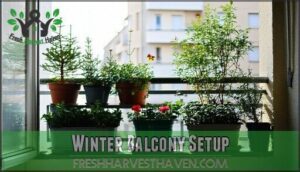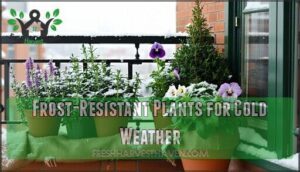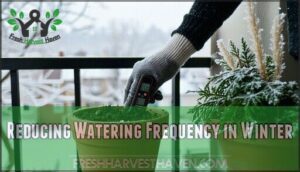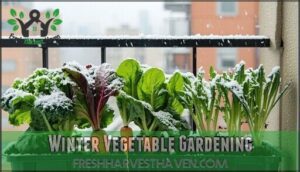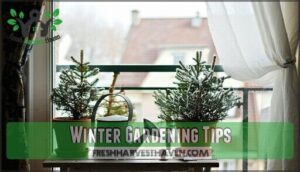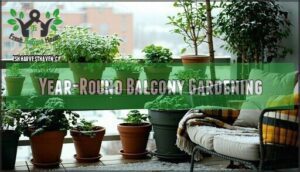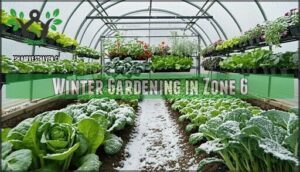This site is supported by our readers. We may earn a commission, at no cost to you, if you purchase through links.
 Winter gardening tips for apartment balconies start with choosing cold-hardy plants like pansies, kale, and evergreen shrubs that can handle frost.
Winter gardening tips for apartment balconies start with choosing cold-hardy plants like pansies, kale, and evergreen shrubs that can handle frost.
You’ll want to wrap tender plants in frost blankets when temperatures drop below freezing. Switch to plastic or fiberglass pots since terracotta cracks in cold weather.
Water less frequently but don’t let soil completely dry out. Position plants against your building’s wall for extra warmth and wind protection.
String lights add both ambiance and a touch of heat. Think of your balcony as a mini greenhouse where every degree matters. The secret lies in understanding which plants actually thrive in winter’s embrace and can be considered as thriving plants.
Table Of Contents
- Key Takeaways
- Winter Balcony Setup
- Plant Selection Guide
- Winter Plant Care
- Top 10 Winter Gardening Products
- 1. 33ft 100 LED Star Fairy String Lights Warm White
- 2. Ciays 42 Inch Outdoor Gas Fire Pit Table
- 3. Large Plant Covers Winter Frost Protection Blankets
- 4. Lenten Rose Hellebore Mix 5 Bareroot Plants
- 5. Dwarf Alberta Spruce Shrub 1 Gallon Green
- 6. Live Healthy Assorted Color Flowering Pansies 4 Pack
- 7. Southern Living Baby Gem Boxwood Hedge Bush
- 8. Erica Kramers Red Spring Heather Shrub
- 9. 5 Tier Stackable Vertical Garden Planter
- 10. 13 Inch Hanging Planters 2 Pack Black
- Balcony Design Ideas
- Winter Vegetable Gardening
- Choosing The Right Pots
- Winter Gardening Tips
- Year-Round Balcony Gardening
- Frequently Asked Questions (FAQs)
- How to turn your balcony into a winter garden?
- How do you winterize an apartment balcony?
- What vegetables are good for apartment balcony?
- Can you have a garden on an apartment balcony?
- What are the easiest vegetables to grow on apartment balcony?
- How to water plants on an apartment balcony?
- How to safely handle balcony garden pests?
- Can companion planting work in small spaces?
- How to repurpose household items for gardening?
- What are DIY options for winter insulation?
- Conclusion
Key Takeaways
- You’ll want to choose cold-hardy plants like pansies, kale, and evergreen shrubs that can handle frost, and don’t forget to wrap tender plants in frost blankets when temperatures drop below freezing.
- To protect your plants from harsh weather, you’ll need to set up your balcony with smart planning, including selecting the right containers, positioning plants to catch maximum sunlight, and creating windbreaks.
- You should reduce watering frequency in winter, as cold temperatures slow plant growth, but don’t let the soil completely dry out – check the moisture by sticking your finger 2 inches deep into the soil.
- By using vertical gardening, like wall planters and hanging baskets, you can maximize your balcony space and grow herbs, greens, and flowers without crowding your garden, even in the winter months.
Winter Balcony Setup
Setting up your balcony for winter gardening requires smart planning to protect your plants from harsh weather while maximizing your limited space.
You’ll need to choose the right containers, position plants to catch maximum sunlight, and create windbreaks that shield your green friends from freezing temperatures.
Choosing The Right Plants for Winter
When winter arrives, your balcony garden doesn’t have to hibernate. Smart plant selection transforms cold balconies into thriving winter gardens.
Transform your chilly balcony into a winter wonderland with the right cold-hardy plants that actually love the cold.
Cold-hardy flowers like pansies laugh at frost, while evergreen choices provide year-round structure. Frost-tolerant herbs such as rosemary and thyme keep your kitchen stocked.
Here’s your winter plant arsenal:
- Seasonal bloomers – Winter heathers bloom December through April
- Balcony veggies – Kale withstands temperatures down to 5°F
- Apartment gardening champions – Dwarf conifers for compact spaces
- Cold weather plants – Hellebores bloom in snow
- Winter vegetables – Spinach germinates quickly in cool temps
Assessing Sunlight and Weather Conditions
Your balcony’s sunlight conditions hold the key to winter gardening success. Track how many hours of direct light different spots receive throughout the day – this Sunlight Duration varies dramatically in winter months.
Check your climate zone and monitor Temperature Extremes to choose plants wisely. Wind Exposure can devastate tender plants, while Microclimates Impact from building walls creates warmer pockets.
- Monitor Precipitation Levels affecting soil moisture
- Identify protected areas with reduced wind exposure
- Map daily sunlight patterns for ideal plant placement
Maximizing Space With Vertical Gardening
When floor space runs short, think upward. Vertical gardening transforms cramped balconies into productive winter gardens.
Wall planters and hanging baskets maximize every inch while tiered gardens create layers of green. Trellis systems support climbing plants, and pallet gardens offer budget-friendly solutions.
Stack containers vertically or mount planters on railings. This small space gardening approach lets you grow herbs, greens, and flowers without crowding your balcony garden during winter gardening season.
This is because vertical gardening improves airflow and plant health.
Plant Selection Guide
Choosing the right plants for your winter balcony garden doesn’t have to feel like solving a science puzzle.
You’ll want to focus on cold-hardy varieties that can handle your specific growing conditions, from frost-resistant bloomers that add color to sturdy herbs that’ll survive even when temperatures drop.
Herbs and Succulents for Beginners
Beginner herbs like sage, rosemary, and thyme make perfect starter plants for your balcony garden.
These winter herbs handle cold temps while easy succulents need minimal water and bright spots.
Both thrive in containers with good drainage and quality potting mix. Light requirements vary, but most beginnerfriendly herbs adapt well.
Start simple—winter care doesn’t have to overwhelm you as a new gardener.
Shade-Loving Plants for Low-Light Conditions
Your balcony doesn’t need bright sun to flourish. Shade-loving plants thrive with less than four hours of direct sunlight daily, making them perfect for north-facing spaces.
Best Varieties for Low-Light Success:
- Ferns and Pothos – These shade-loving greens handle dim conditions beautifully, requiring consistent moisture and well-draining soil
- Peace Lilies – Elegant plants for balcony without sunlight that signal watering needs through drooping leaves
- Small Boxwood – Sturdy shade-loving plants offering year-round structure with minimal light optimization required
Frost-Resistant Plants for Cold Weather
When temperatures drop, you’ll want frost-tolerant plants that laugh in winter’s face.
Hardy herbs like rosemary and thyme bounce back from freezing nights. Winter bloomers such as pansies and hellebores add color when everything looks bleak.
Evergreen varieties like dwarf boxwood keep your balcony garden looking alive year-round.
These cold hardy plants need solid frost protection—wrap containers in burlap and group them together for extra warmth during harsh winter gardening months.
Winter Plant Care
Your balcony plants need extra care when winter arrives, just like you need a heavier coat when temperatures drop.
You’ll protect them from frost, water them less often, and switch to fertilizers that won’t shock their roots during cold months.
Protecting Plants From Frost and Freeze
You’ve picked your plants—now it’s time to armor them against winter’s bite.
Pot Insulation works wonders; wrap containers with bubble wrap or burlap to prevent root freeze.
Frost Blankets shield tender leaves from icy winds.
Mulch Application around plant bases adds extra warmth.
For severe cold, Enclosure Construction using chicken wire and leaves creates protective barriers.
Overwintering Indoors saves delicate specimens.
Proper insulation can help maintain consistent temperatures.
Reducing Watering Frequency in Winter
Winter’s chill changes everything about your balcony garden watering routine. Cold temperatures slow plant growth, putting most greenery into dormancy mode. Your soil stays wet longer, making Root Rot Prevention essential for healthy plants.
Consider that watering restrictions apply depending on your location.
Smart Watering Schedule adjustments include:
- Soil Moisture Checks: Test dirt 2 inches deep—if it’s moist, skip watering
- Lukewarm Water application: Prevents shocking sensitive roots during cold snaps
- Morning watering: Allows excess moisture to evaporate before freezing temperatures hit
Using Winter-Friendly Fertilizers
Just as you’ve scaled back watering, your fertilizing approach needs adjustment too.
Slow-release benefits shine in winter—they won’t shock dormant roots like fast-acting options. Choose low-nitrogen options since plants aren’t actively growing.
Organic alternatives like compost work perfectly for your balcony garden. Store winter-friendly fertilizers in cool, dry spots.
Application frequency drops to once monthly maximum. For convenient options, consider browsing a variety of products.
Your winter vegetables will thank you for this gentler approach.
Top 10 Winter Gardening Products
You’ll need the right tools and products to turn your winter balcony into a thriving garden space.
These ten essential items will help you protect your plants from cold weather while creating a cozy outdoor retreat that works all season long.
1. 33ft 100 LED Star Fairy String Lights Warm White
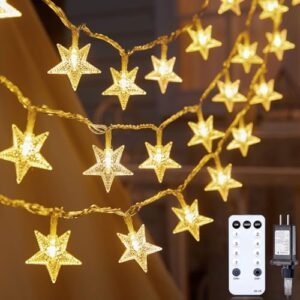
After caring for your winter plants, you’ll want to create an inviting atmosphere that makes spending time outdoors enjoyable. These 33ft 100 LED star fairy string lights transform your apartment balcony into a cozy winter retreat.
Their Warm White Benefits create a soft, welcoming glow that enhances your balcony garden without harsh brightness. Star Light Durability means they’ll withstand winter weather, while LED Energy Efficiency keeps electricity costs reasonable.
Smart String Light Placement around railings or through plants adds magical Winter Ambiance Lighting to your space.
- Weather-resistant design handles snow, rain, and freezing temperatures
- Remote control lets you adjust brightness and set timers effortlessly
- Energy-efficient operation won’t spike your monthly electric bill
Best For: Anyone wanting cozy balcony decor for winter gardening spaces.
2. Ciays 42 Inch Outdoor Gas Fire Pit Table
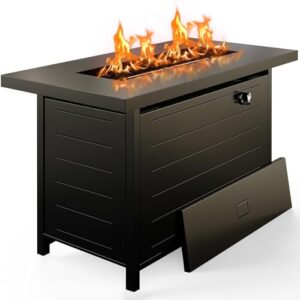
Your balcony garden deserves warmth that doubles as entertainment.
The Ciays 42 Inch Outdoor Gas Fire Pit Table transforms your winter gardening space into a cozy retreat with its impressive 60,000 BTU output.
This table material combines durability with style, featuring lava rock accents that create visual appeal while you tend to your plants.
Fire pit safety comes standard with easy propane connections and stable construction.
The weather resistance handles winter conditions, though you’ll want a protective cover for longevity.
Fuel efficiency keeps costs reasonable while creating a cozy atmosphere for your balcony garden ideas.
At 42 inches, it fits most spaces without overwhelming your winter garden care routine.
Best For: Gardeners wanting functional warmth that enhances their winter gardening experience.
3. Large Plant Covers Winter Frost Protection Blankets
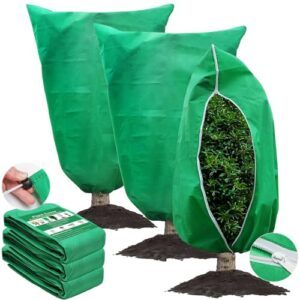
You’ll love Large Plant Covers for winter gardening.
They’re reusable, eco-friendly, and lightweight, making them easy to install.
These frost protection blankets shield plants from snow, frost, and pests, while allowing air and sunlight to pass through.
Breathability is key to preventing moisture buildup.
Consider blanket material types, application methods, and storage solutions for ideal use.
As a plant insulation technique, they’re a great alternative to other winter plant shields, providing a cozy coat for your plants and keeping them safe from harsh winter conditions with proper blanket breathability concerns in mind.
4. Lenten Rose Hellebore Mix 5 Bareroot Plants
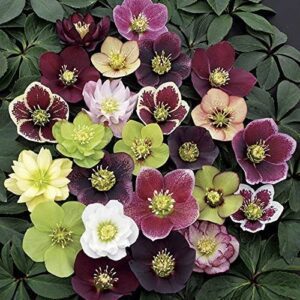
After securing frost protection, you’ll want plants that actually thrive in winter’s grip.
Lenten Rose Hellebore Mix delivers exactly that – five bareroot plants that treat cold weather like a vacation.
These evergreen perennials produce stunning winter blooms in unexpected colors while most plants sleep through the season. Their cold hardiness spans zones 4-9, making them perfect balcony plants for container gardening.
What sets these hellebore varieties apart? They bloom from late winter through early spring, offering nodding, papery flowers when your balcony garden needs color most.
Bareroot planting means they establish quickly in pots. At 18-24 inches tall, they won’t overwhelm small spaces but provide year-round structure.
The rose mix brings surprise colors to your winter gardening setup without fuss. These plants can also add multi-season visual appeal with proper selection.
5. Dwarf Alberta Spruce Shrub 1 Gallon Green
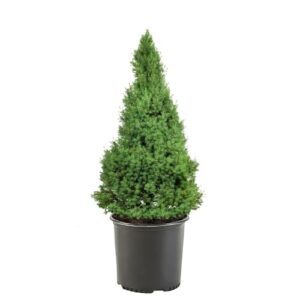
When space is tight, the Dwarf Alberta Spruce becomes your balcony’s green superhero. This compact conifer delivers year-round charm without hogging precious square footage. Winter hardiness makes it perfect for container gardening, thriving in temperatures that send other plants packing.
Choose a container that’s at least 18 inches wide to give roots room to breathe. Dwarf conifer varieties like this one need well-draining soil and protection from harsh winds. Position it near your building’s wall for extra warmth during bitter cold snaps.
Pruning techniques are minimal – just pinch new growth tips in spring to maintain shape. Spruce care tips include watering when soil feels dry and avoiding fertilizer during winter months. This small shrub transforms any balcony garden into a festive winter wonderland.
Best For: Container gardening enthusiasts wanting low-maintenance evergreen charm.
6. Live Healthy Assorted Color Flowering Pansies 4 Pack
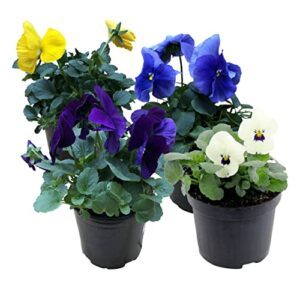
Colorful pansies pack serious punch for your winter gardening adventure.
These cheerful winter flowers laugh in the face of cold weather, tolerating temperatures down to 15°F while other plants wave the white flag.
Pansy Color Variety ranges from deep purples to sunny yellows, giving your balcony garden the rainbow treatment it deserves.
Pansy Sunlight Needs are invigoratingly flexible – they’ll bloom happily in full sun or partial shade, making them perfect balcony plants for any exposure.
Pansy Watering Tips are simple: keep soil consistently moist but not soggy.
Think of it like a wrung-out sponge.
Pansy Cold Tolerance makes them winter warriors, while their compact 9-inch height won’t crowd your space.
For Pansy Pest Control, watch for aphids and treat with insecticidal soap.
These edible blooms also transform boring salads into Instagram-worthy masterpieces.
7. Southern Living Baby Gem Boxwood Hedge Bush
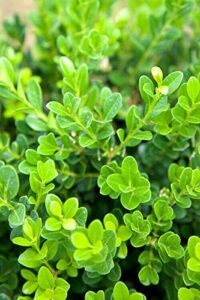
While pansies bring cheerful color to your winter balcony garden, Southern Living Baby Gem Boxwood Hedge Bush delivers year-round structure and sophistication.
This compact evergreen shrub works perfectly for container gardening on small balconies. You’ll love how its glossy, dark-green foliage maintains color through winter months.
These small shrubs reach just 2-3 feet tall, making them ideal balcony plants that won’t overwhelm your space.
Boxwood Winter Care is surprisingly simple—they’re naturally cold-hardy and drought-tolerant. Container Size should be at least 12 inches wide for proper root development.
Sunlight Needs are flexible; they thrive in partial shade to full sun. Pruning Techniques involve light shaping in spring, while Disease Prevention requires good drainage to avoid root rot.
Best For: Creating elegant, low-maintenance structure in your balcony garden.
8. Erica Kramers Red Spring Heather Shrub
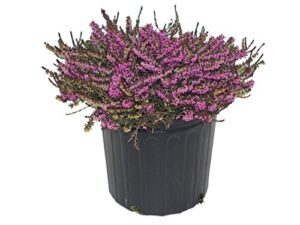
While boxwood provides structure, you’ll want something that blooms to brighten those dreary winter months. Erica Kramer’s Red Spring Heather Shrub delivers exactly that punch of color your balcony garden craves.
This compact powerhouse showcases deep purplish-red blooms in early spring, making it one of the standout heather varieties for winter balcony gardening. Its fine, needle-like foliage and manageable size (18-24 inches tall, 2-3 feet wide) work perfectly in containers.
The red spring blooms appear when most plants are still sleeping, giving you bragging rights among fellow gardeners. Winter hardiness in USDA Zones 5-8 means it’ll survive your coldest nights.
Soil requirements include well-draining, slightly acidic conditions. Pruning techniques are minimal – just remove spent flowers after blooming. This winter heather proves that coldhardy plants can be both beautiful and practical for small-space gardening.
9. 5 Tier Stackable Vertical Garden Planter
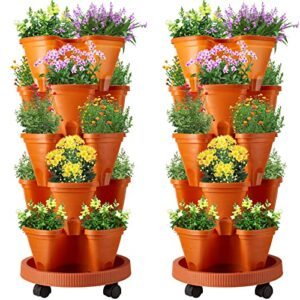
After adding heather for year-round color, you’ll want to maximize your balcony garden space efficiently. The 5 Tier Stackable Vertical Garden Planter transforms cramped quarters into a productive growing tower.
This vertical gardening solution offers impressive Stackable Planter Benefits through smart Space Optimization. The sturdy design assembles quickly with an interlocking system that keeps everything stable.
Built-in filters handle moisture retention, though Watering Challenges require checking each tier regularly since water flows downward. The Tiered Garden Design works perfectly for herbs, strawberries, and leafy greens in your container gardening setup.
Casters let you move it easily for frost protection during harsh weather. While wheels could be sturdier, this lightweight option adapts beautifully to indoor or outdoor winter gardening tips. Just verify dimensions before ordering.
10. 13 Inch Hanging Planters 2 Pack Black
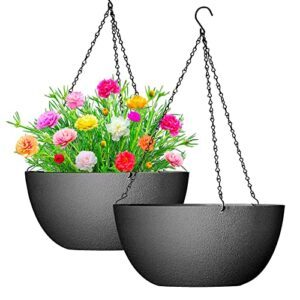
While vertical gardens work great for ground-level space, hanging plants take your winter balcony gardening to the next level. These 13-Inch Hanging Planters in sleek black deliver both style and function for your balcony garden.
The Black Planter Aesthetics complement any outdoor decor, while the Planter Material Durability handles winter weather without cracking. At just the right Hanging Planter Weight, they won’t strain your balcony railings, and the Two-Pack Value gives you flexibility for creative arrangements.
Here’s what makes them perfect for container gardening:
- Adjustable hanging chains let you create layered displays
- Built-in drainage holes prevent waterlogged roots during winter plant care
- 13-inch Hanging Planter Size accommodates herbs, succulents, or trailing flowers
They’re your ticket to maximizing vertical space while keeping plants happy year-round.
Balcony Design Ideas
You can transform your winter balcony into a warm, inviting space that makes you actually want to spend time outdoors even when it’s cold.
Smart design choices like adding cozy lighting, soft textiles, and heat sources will create a comfortable retreat where your plants and you can both thrive during the chilly months, making it a perfect spot to enjoy with warm surroundings.
Creating a Cozy Atmosphere With Lighting
When winter nights stretch longer, soft lighting turns your balcony into a warm sanctuary.
String fairy lights along railings for magical ambiance, choosing warm color temperature over harsh white bulbs. Strategic light placement creates depth and highlights your plants beautifully.
You can even find unique string light designs online.
- Fairy Lights: Drape around railings and planters for enchanting glow
- Lantern Choices: Battery-powered options provide portable ambient lighting without cords
- LED Lights: Energy-efficient strips accent architectural features and plant displays
- Solar Lamps: Eco-friendly pathway lighting that charges during short winter days
Using Textiles and Rugs for Comfort
Your balcony transforms into a winter retreat with the right textiles and rugs.
Choose weather-resistant rug materials that provide textile insulation against cold surfaces.
Cozy textures like outdoor cushions and throw blankets create warmth while adding color psychology through rich, inviting hues.
These insulation techniques make your cozy balcony comfortable for tending winterizing balcony plants year-round, utilizing textile insulation effectively.
Incorporating Fire Elements for Warmth
Fire elements transform your balcony garden into a winter sanctuary that’s both warm and inviting.
Ethanol fireplaces offer clean-burning heat without requiring gas lines, while chiminea options provide classic charm for larger spaces.
Always prioritize fire pit safety by using heat-resistant surfaces underneath any heating element.
- Tabletop fire bowls: Perfect for intimate settings and easy storage
- LED candle arrangements: Safe alternatives that mimic real flames beautifully
- Portable propane heaters: Instant warmth for those chilly gardening sessions
Winter Vegetable Gardening
You can grow fresh vegetables on your balcony even when temperatures drop, turning your outdoor space into a productive winter garden.
Cold-hardy crops like kale, spinach, and carrots actually taste sweeter after frost exposure, making winter the perfect time to discover how resilient these plants can be, and to enjoy winter as the perfect season.
Easy-to-Grow Winter Vegetables for Balconies
Growing your own winter veggies on a balcony isn’t rocket science.
Radish growing takes just 30 days, while carrot care involves deep containers for straight roots.
Garlic planting in fall yields spring harvests.
These winter-hardy plants laugh at cold temps and deliver fresh flavor.
Winter cultivation means choosing varieties bred for chilly weather.
Your winter vegetable gardening success depends on selecting easy-to-grow winter vegetables that handle apartment balcony conditions like champions.
Leafy Greens Varieties for Winter
For winter vegetable gardening, leafy greens varieties are your friends. They’re cold-tolerant and easy to grow on an apartment balcony.
Here’s what you can try:
- Winter Kale
- Frosty Lettuce
- Green Spinach
- Leafy Mustard
- Cold Hardy Chard
Enjoy a winter harvest of nutrient-rich winter veggies. Kale varieties sweeten after frost. Spinach types thrive in pots. These are perfect for your balcony garden.
Root Vegetables Adaptations for Cold Weather
Once you’ve mastered leafy greens, root vegetables offer another winning strategy for your winter balcony garden.
These underground champions excel at energy storage, tucking away nutrients that help them survive freezing temps. Root vegetables adaptations include natural dormancy mechanisms that actually improve their taste through flavor enhancement – carrots and parsnips literally get sweeter after frost hits.
Cold-tolerant plants like these thrive with proper soil insulation techniques. Their impressive frost tolerance means you’ll harvest winter veggies even when other crops have given up the ghost.
Vegetable Cold Tolerance Storage Tip Growth Method
Choosing The Right Pots
Your pot choice can make or break your winter balcony garden since the wrong material will crack when temperatures drop below freezing.
You’ll want to skip those pretty terra cotta and ceramic pots this season and grab lightweight options like fiberglass or thick plastic containers that can handle the cold without splitting apart, which is crucial for the winter balcony garden.
Selecting Pots With Insulation Properties
Winter gardening success starts with smart pot material choices.
Plastic pots excel at frost protection because they’re lightweight and resist cracking, unlike terracotta pots that split when frozen.
For maximum results, choose container size of at least 12 inches diameter with proper pot thickness.
Essential drainage solutions for winter containers:
- Lightweight options like fiberglass prevent freeze damage
- Add drainage holes to stop water pooling
- Use larger pots for better root insulation.
This approach guarantees thriving plants all season.
Using High-Quality Potting Mix for Vegetables
Your pot choice matters, but the soil inside makes or breaks your winter vegetable garden.
High-quality potting mix beats regular dirt every time for container gardening. Look for blends with organic amendments like compost and perlite—they boost nutrient retention while maintaining proper drainage properties.
Check the soil pH matches your vegetable types; most prefer slightly acidic to neutral levels. Skip garden soil entirely; it compacts in containers and drowns roots.
Quality potting mix costs more upfront but delivers healthier plants and better harvests throughout winter.
Avoiding Terracotta and Ceramic Pots in Winter
Terra cotta and ceramic pots become your garden’s worst enemy when temperatures drop. Water trapped inside expands during freezing, causing cracks that’ll ruin your pot material durability.
Switch to lightweight pot options like plastic or fiberglass for better pot cracking prevention. These alternative pot materials offer superior insulation pot thickness for frost protection.
- Plastic containers retain heat better and won’t shatter when ice forms inside
- Fiberglass planters provide excellent insulation while remaining portable for repositioning
- Resin pots mimic ceramic’s appearance but handle freeze-thaw cycles without breaking
Winter Gardening Tips
You’ve got your pots ready and plants selected, but winter balcony gardening success comes down to staying on top of three key maintenance tasks.
Regular check-ups on your green friends will keep them healthy through the cold months and set you up for a thriving spring garden.
Maintaining a Neat and Ready Balcony
Your balcony’s cleanliness directly impacts your winter balcony gardening success. A well-maintained space prevents pest problems and keeps your winterizing balcony plants healthy.
Follow these balcony cleanliness tips for effective winter plant care:
- Debris Removal – Clear fallen leaves and dead plant material weekly
- Surface Cleaning – Sweep floors to prevent mold and fungal issues
- Furniture Storage – Stack or fold items to maximize growing space
- Tool Organization – Keep pruners and watering tools easily accessible
These balcony garden maintenance steps create an organized foundation for thriving plants. To further enrich the soil, consider amending it with compost after checking soil pH balance.
Regularly Inspecting Plants for Pests and Diseases
Most gardeners forget that winter doesn’t give pests a vacation—early detection keeps your balcony garden healthy. Check plants weekly, focusing on leaf undersides where aphids love to hide. Look for sticky honeydew, discoloration, or abnormal growth that signals trouble brewing.
Disease prevention starts with spotting white powdery spots or yellowing edges before they spread. Natural remedies work best: natural insecticidal soap tackles soft-bodied pests, while neem oil spray fights fungal issues.
Winter stressors weaken plants, making plant maintenance essential for pest control success.
Adjusting Watering Frequency for Winter
Winter’s shorter days mean your balcony garden drinks less water.
Soil moisture checks become essential—stick your finger an inch deep to gauge thirstiness.
Root rot prevention starts with avoiding soggy conditions that freeze overnight. Lukewarm water use prevents shocking cold roots.
During dormancy watering needs, water sparingly when temperatures climb above 40°F. Evaporation considerations matter less in winter’s humidity.
Year-Round Balcony Gardening
You can keep your balcony garden thriving all year long by adjusting your care routine with each season’s changing needs.
The key is gradually moving plants between indoor and outdoor spaces while monitoring their water, light, and temperature requirements throughout the year, which is crucial for a thriving garden.
Gradually Introducing Plants to Outdoor Conditions
Easing your plants back outside requires patience and strategy. Spring Acclimation prevents shock when moving from protected indoor spots to your balcony garden. Hardening Off strengthens plants gradually through controlled Sunlight Exposure and Temperature Adjustment.
Follow this plant acclimatization process:
- Start with 2-3 hours outdoors on mild days
- Increase exposure time by one hour daily
- Monitor plants for stress signs during temperature change
Cold-hardy and frost-resistant varieties adapt faster to outdoor conditions. This plant adjustment period typically spans 7-10 days, ensuring your winter gardening success continues smoothly into spring.
Continuing to Provide Adequate Water and Light
Once your plants adjust to outdoor life, maintaining the right watering schedule becomes your daily ritual.
Check soil moisture weekly—stick your finger two inches deep.
Winter sunlight is scarce, so position containers where light reflection off walls helps.
When natural light fails, grow lights placed 12-24 inches above plants work magic.
These watering techniques and sunlight strategies keep your balcony thriving year-round.
Monitoring Plants For
Stay vigilant with your pest detection routine – check leaves weekly for aphids or spider mites.
Watch for disease signs like yellowing or wilting, and monitor moisture levels using your finger test.
Track growth rate changes and inspect for cold damage after temperature drops.
These simple winter balcony gardening checks prevent small issues from becoming major headaches.
Frequently Asked Questions (FAQs)
How to turn your balcony into a winter garden?
Transforming your balcony into a winter wonderland isn’t rocket science.
Choose cold-hardy plants like pansies and rosemary, use insulated containers, position them for maximum sunlight.
Protect from harsh winds with covers, and by doing so, you will be able to enjoy your winter wonderland.
How do you winterize an apartment balcony?
Wrap containers in bubble wrap or burlap to prevent cracking.
Move plants against your building’s wall for extra warmth.
Cover delicate plants with frost cloth during cold snaps, and reduce watering frequency substantially.
What vegetables are good for apartment balcony?
Your balcony’s like a tiny farm waiting to flourish.
You’ll love growing leafy greens like spinach and kale, plus compact root vegetables such as carrots and radishes that thrive in containers.
Can you have a garden on an apartment balcony?
You absolutely can have a garden on your apartment balcony.
Container gardening works perfectly in small spaces.
Choose lightweight pots, select plants suited to your light conditions, and you’ll be growing fresh herbs and vegetables in no time.
What are the easiest vegetables to grow on apartment balcony?
Leafy greens like spinach and kale are your best bet for balcony success.
They’re cold-hardy, grow quickly, and don’t need deep containers.
Carrots and radishes also thrive in smaller spaces with minimal fuss.
How to water plants on an apartment balcony?
Check soil moisture with your finger before watering.
Water early morning when temps rise above 40°F.
Use lukewarm water and make certain good drainage.
Position containers to catch natural rainfall when possible.
How to safely handle balcony garden pests?
You’ll want to inspect your plants regularly, then use insecticidal soap or neem oil to treat pests like aphids and spider mites, and remove any damaged foliage to prevent disease.
Can companion planting work in small spaces?
You can grow a tiny forest with companion planting, even in small spaces, by carefully selecting and placing plants together to enhance growth and reduce pests.
How to repurpose household items for gardening?
You can repurpose household items like old containers, cardboard tubes, and eggshells as planters, trellises, or seed starters to create a unique and eco-friendly garden.
What are DIY options for winter insulation?
You can use DIY options like bubble wrap, burlap, or straw to insulate your plants from harsh winter conditions, protecting them from frost and freezing temperatures easily.
Conclusion
Seriously, who says you can’t garden in winter?
You’re now a pro at winter gardening tips for apartment balconies.
Go ahead and give those cold-hardy plants some love.
With these tips, you’ll be enjoying your mini greenhouse in no time, and mastering winter gardening tips for apartment balconies will be a breeze.

